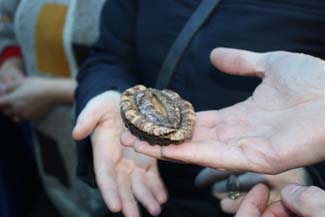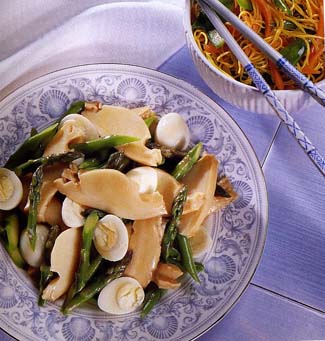Abalone
 Abalone are a highly prized shellfish delicacy, now scarce in most countries where they were once plentiful. Known as much for their beautiful iridescent shells as for the delicately flavoured meat, this exotic shellfish is not something one might expect to find in the rugged surroundings of the West of Ireland and, except for flurry of interest at this time of year when they are in demand for the Chinese New Year celebrations in Ireland, most of the production is exported.
Abalone are a highly prized shellfish delicacy, now scarce in most countries where they were once plentiful. Known as much for their beautiful iridescent shells as for the delicately flavoured meat, this exotic shellfish is not something one might expect to find in the rugged surroundings of the West of Ireland and, except for flurry of interest at this time of year when they are in demand for the Chinese New Year celebrations in Ireland, most of the production is exported.
(Now in its fourth year, the Dublin Chinese New Year Festival celebrates Sino-Irish relations by showcasing Chinese culture and heritage – in which food plays an important part. The 2011 activities take part at various locations during the first fortnight of February; see www.visitdublin.com/events). Connemara Abalone is sometimes showcased in local restaurants such as the Matz at the g, at the stylish g hotel in Galway city.
About 80 different abalone species are native to the warm temperate waters off Japan, China, California, Mexico, South Africa, Australia, New Zealand, and France, but wild abalone fisheries in most of those countries are now either closed or severely restricted. Demand for abalone remains strong, however, so in order to supply the market, they must be farmed.
Connemara Abalone was started in 2002 by Cindy O'Brien. As a California native with a degree in Marine Biology from Cal. State University, Long Beach, Cindy has long been familiar with abalone and their aquaculture.
 Having moved to Ireland in 1996 with her Irish husband and young children, Cindy saw the pristine waters (and abundant seaweed) off Connemara as an ideal environment in which to raise abalone. Moreover, two species of abalone had already been introduced to Ireland by BIM and NUIG's Cama Research Lab., so both technical and financial support was readily available from Irish government agencies (Údarás na Gaeltachta, BIM, Bord Bia), and greatly appreciated.
Having moved to Ireland in 1996 with her Irish husband and young children, Cindy saw the pristine waters (and abundant seaweed) off Connemara as an ideal environment in which to raise abalone. Moreover, two species of abalone had already been introduced to Ireland by BIM and NUIG's Cama Research Lab., so both technical and financial support was readily available from Irish government agencies (Údarás na Gaeltachta, BIM, Bord Bia), and greatly appreciated.
Technically, abalone are single-shelled gastropods (a group that includes clams, scallops) that feed on seaweeds. Apart from their shell, they are almost pure protein. In fact they are the most efficient way known to nature of converting red or brown algae into white protein. They are also rich in Omega-3 and other minerals (typical Omega-3 content is 500mg per 100g of raw abalone).
It takes approximately 4 years for abalone larvae to reach market size of 7-8cm length. Connemara Abalone has its own hatchery at the farm, so it can spawn and raise abalone from larvae right up to adult size; for the final three years or more their diet is abundant locally and free – fresh seaweed. At the end of this process they are shipped from their tanks to market, where they must live up to their reputation as the "truffles of the sea".
The texture of a raw abalone is quite firm, but once cooked (for just 30-40 seconds in most recipes) it can be cut like butter and has a sweet, nutty flavour.
Abalone can be served with creamy or spicy sauces, or just drizzled with lemon or lime. They are quite filling so suggested serving size is 2-3 abalone for an appetizer, and 5 to 6 for a main course. There are over 100 different recipes and methods for cooking abalone; see www.abalone.ie for more easy-to-follow recipes.
Connemara Abalone, Aille, Barna, Co Galway. Visitors welcome by arrangement. For further information: call +353 (0)91 591307, email info@abalone.ie, or see www.abalone.ie for ordering and shipping details (normally by overnight courier to your door).
 RECIPE : ABALONE WITH OYSTER SAUCE
RECIPE : ABALONE WITH OYSTER SAUCE
You can steam, sauté, bake, poach, boil, or barbecue abalone, or eat them raw like oysters. To prepare for cooking, use a spoon to "shuck" the meat from the shell; relax the meat with the back of a wooden spoon or mallet, and cook by your chosen method.
This simple stir-fried dish is adapted from a recipe in The Chinese Kitchen by Deh-Ta Hsiung; this well known expert on Chinese cooking is based in England and visited Ireland on behalf of Egon Ronay Guides and, more recently, to assess Chinese restaurants for GC Guides. The Oyster sauce lends an extra dimension to the flavours.
Click for recipe





There are currently no comments
Leave a comment
Not a member? Register for your free membership now!
Or leave a comment by logging in with: